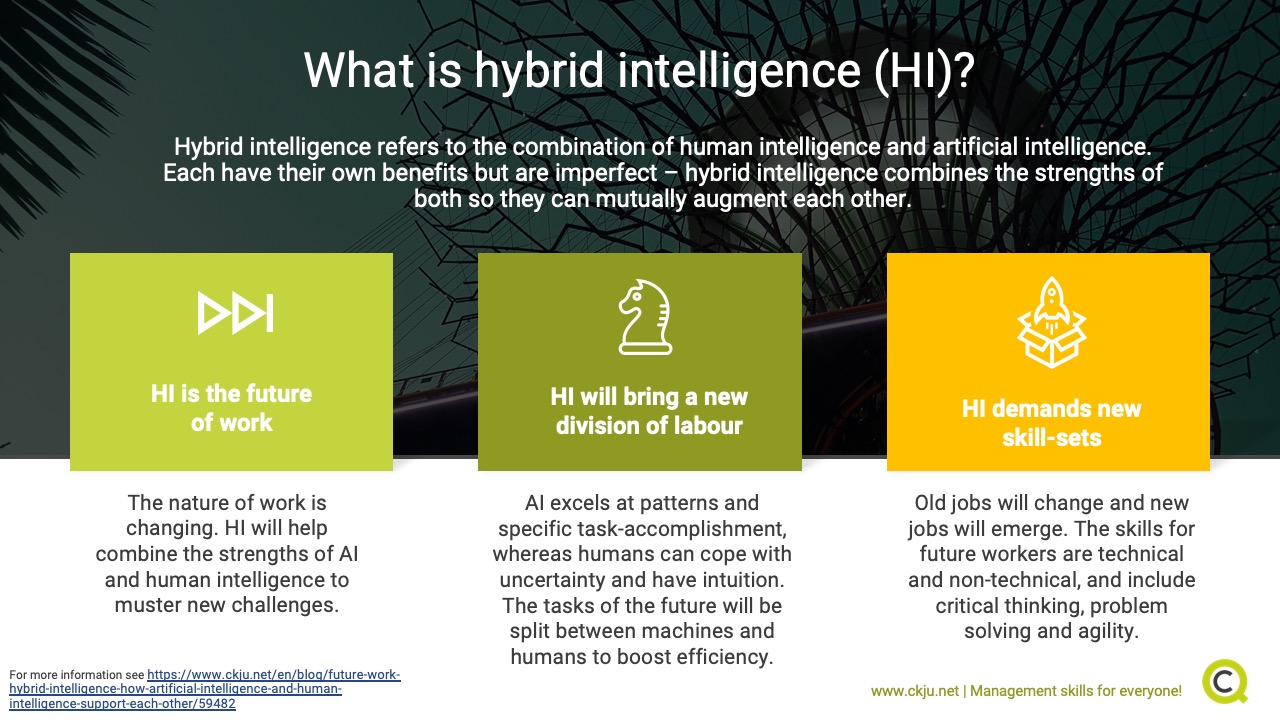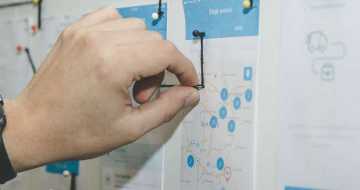- Blog
- Hybrid Intelligence
Contents
What is Hybrid Intelligence?
In the digital age, the bulk of the work will be done by Hybrid Intelligence that brings together human and artificial intelligence (AI), leveraging their complementary abilities that, when combined, augment each other. The tasks that artificial and human intelligence excel at are quite different. This fact is known as Moravec’s paradox, which states that it is comparatively easy to make computers perform well on intelligence tests or play chess, but difficult or even impossible to give them perception and mobility skills of a one-year-old child (Moravec, 1988).
This is particularly true for the human common sense that is challenging to achieve in AI. There are still lots of problems that machine learning systems cannot yet solve alone, such as applying knowledge to decision making, planning, or creative tasks. In particular, they have significant difficulties with being adaptive to dynamic environments and self-adjusting, lack of what we call common sense (Lake et al., 2017).
Artificial intelligence is (still) narrow in nature, while the human is general. It is very good at conducting specific, well-defined tasks based on a particular type of data and in a controlled environment. Artificial general intelligence would need a massive amount of training data compared to humans, who can learn from only a few examples and fails to work with specific data types, such as soft data (Dellermann et al., 2019). This is where humans have an unparalleled competitive advantage, and this will be essential to keep in mind.
Why is Hybrid Intelligence important?
Because the brain and AI use fundamentally different algorithms, each excels in ways the other utterly fails. Machine learning algorithms are better than people at finding complex and subtle patterns in massive data sets. But the brain can process information efficiently even when there are noise and uncertainty in the input – or under unpredictably changing conditions (Silva G., 2019). This is why human intelligence and artificial intelligence need to work together and join forces as hybrid intelligence. Research confirms this is exactly how executives see the future of work: 67% of them say AI will help humans and machines work together to leverage their own strengths (PwC, 2018b).
On top of this, there are some more very specific reasons that underline the relevance of hybrid intelligence for the future of work:
AI is here to stay
AI is a general-purpose technology because of its broad spectrum of applications in nearly every industry. According to a recent global CEO survey, the majority of large companies (77%) are investing in AI technologies or intend to do so over the next three years (PwC, 2018b). AI is not just the future of technology; it is embedding in every aspect of our lives.
AI will change jobs. Most, if not all of them
It is difficult to project what portion of today’s jobs will be swept away with it, but it is not far-fetched to estimate that the share of jobs that will change is – 100%. With digitalisation and a hyper-connected world, few are the jobs that are safe from changing in the next ten years. Machines will do the things they are good at, and people will work what they are good at.
A new division of labour is emerging
The new division of labor is emerging. The brain could do certain things computationally and other things by different means. What AI can replicate is what we do in the computational part of our brain, and probably not everything there. What will, however, stay out of its reach is what we do in our non-computational brain (McDermott, 2007).
How to utilize Hybrid Intelligence for your career development?
How can a professional embrace Hybrid Intelligence as the future model of work? First, by being strategic about the job. The most profound finding of a recent research that analyzed around a billion job postings and employee resumes from millions of companies, was that high-paying jobs of the future are more complex, multi-disciplinary, and hybrid (Burning Glass Technologies, 2019). The line between the jobs is blurring. Second, by developing the hybrid skills set to match the high-paying hybrid job of the future. This is a broad set of both technical and non-technical skills from different fields (Burning Glass Technologies, 2019).
The following are the actionable steps that will help you, as a professional, get a strategic take on your job, and excel in the age of Hybrid Intelligence.
Think about your job as a bundle of individual tasks and re-evaluate them against their automatability. Do that often.
Keep an eye on how your job is developing. It is useful to think of the work as not a job description or a title, but as a bundle of tasks that it consists of. Think about which of these tasks are mechanical, structured, driven by stricter rules, or steps. These are under higher risk automation. What can be structured will be automated sooner or later.
Then think of the aspects of your job that are not easy to codify, that are more random, unpredictable. Those would be activities, for example, when research about a new product or a market or a potential client is done. Essentially, whenever we tap into uncharted territory. In these cases, we use our knowledge and draw upon existing experience, often from multiple domains, enriching them by a layer of creativity and even imagination. We apply these capabilities in an entirely new context to come up with an optimal solution for the new endeavor. This is something that is a product of a human, general intelligence, and these capabilities are still hard to mimic by AI.
For this reason, they will come at a premium in the workplace of the future. And to tie this back to the concept of jobs as bundles of individual tasks – try to enrich your role with this type of task as much as possible. It will serve you well in the job market of the future.
Another useful framework to use is the Robot Curve (Neumeier, 2012). Essentially, moving up the Robot Curve is what to strive for. At the top of the curve stands creative work that includes scientific discoveries, product inventions, and new business ideas. A step down is skilled work, such as the work of professionals. This work was once original, but later it became best practices. As skilled work gets more standardized or transformed by technology, it becomes rote work that is often outsourced, and eventually automated.
Rethink the workplace
The digital platform economy is gaining traction. The workplace may not be only a brick and mortar office that you go to every morning as new formats of work and the workplace are emerging. Stay connected to this work format even if you don't plan to participate actively. It will help you stay informed of what skills are in high demand, what jobs are emerging, what pays well, and what is in decline. It is the labour market at your fingertips.
Forget about the three-stage life-cycle: Learn, work, retire
The three-stage lifecycle is over, and lifelong learning is a must. First, we live longer. Being retired for decades is not sustainable, and learning only until the 20s is neither. Second, the speed of change is such that learning becomes continuous. As the education system is lagging, employers need to step up and fill the skill gap. But you want to keep yourself updated with the latest developments, too. Self-motivated learning is a crucial skill that also gives the confidence that comes with taking your learning curve, and consequently, career under your own control.
Specialise in a chosen domain, but always try to test the surrounding waters
The specialisation is necessary to become an expert. However, in the age of constant change, it is wise not to get too hung up on the confines of the current job and the notion of what it currently entails. As David Epstein explains in his recent book, Range, diverse experiences are helpful in many domains, particularly business, science, and arts. One of the key ideas of the book is that specialisation works in so-called “kind” environments, but it’s not as useful for thriving in “wicked” settings, where it pays off to be a generalist.
The kind environment is one where all the information is available, patterns repeat, feedback on everything you do is immediate and accurate, and there’s no human behavior involved other than your own. These are activities like chess or golf.
On the opposite side of the spectrum are wicked environments, where decisions are made based on judgments as the available information set is limited; situations are dynamic and involve other people and, feedback is not automatic and is often partial and inaccurate (Epstein, 2019).
Going by these descriptions, the business environment is wicked, and as it's growing increasingly complex, it will become more and more so. Becoming too much of a specialist can narrow focus and hinder your growth and flexibility in this rapidly changing environment.
Gain depth, but leave some room for the breadth in knowledge and experience. Build credentials and credibility as a result of that. You want cross-sectional skills that hover over the border between domains, because that way, you will leverage the developments in both of them, and typically, cross-domain skills come with a premium. So, focus, but test the surrounding waters too and pivot when an opportunity arises.
Cognizant (2018) illustrates emerging jobs that are expected to become prominent in the next ten years that is helpful for making sense of where the future job market is heading. Some of the jobs look surprising, but stay open-minded - as we are heading closer to 2028, they will start becoming mainstream. Remember that only several years ago, digital marketing career didn't exist, and now it is hard to imagine a company without an online presence.
What are the skills to develop to be ready to master Hybrid Intelligence?
As AI takes over routine and menial tasks, humans will be freed up to do what they excel at - to think critically and creatively and to imagine new possibilities while creating meaningful relationships and connections.
Hybrid skills, those that require both technical and non-technical capabilities, are in high demand. A study that examined the US labour market between 1980 and 2012 confirmed that the market increasingly rewards social skills as jobs requiring high levels of social interaction grew by nearly 12 percentage points as a share of the total labor force. In contrast, math-intensive but less social jobs - including many STEM jobs - decreased by 3.3 percentage points. Employment and salary growth was particularly strong for jobs requiring high levels of both math skill and social skill (Deming, 2017).
These are the skills to develop to thrive in the age of Hybrid Intelligence:
Digital skills
Unless your career is in IT or data analytics, developing digital skills does not necessarily mean that you need to start coding or do Machine Learning. But it does mean that a general proficiency in using data and knowing how to interpret them and make informed decisions about their business applications will be expected. Hardcore digital workers will be confined to specialised departments, but workers across the board will be expected to be comfortable around data. They will have to understand the basics of data science and data visualization and also something about how AI “thinks.” (PwC, 2018a).
Problem-solving and critical thinking; lateral thinking
In the age when data is abundant, and algorithms can process them, providing answers almost instantly, asking relevant questions is the skill that becomes critical. When asking questions and assessing the solutions, questioning the claims rather than taking them at face value is vital. Approaching both problems and solutions from a different angle is also a valuable skill.
Decisiveness
Effectively making decisions in the fast-paced world is critical. But gaining insights from the data and knowing how to interpret them means nothing without acting upon them. Decisiveness becomes an essential skill (Birkinshaw, 2019).
Communication and collaboration
In a world of increasing complexity, multidimensional problems emerge. The best approach to solving them involve collaboration between people with different skills and backgrounds. Navigating this diverse and complex landscape is a skill in itself, and a sought after at that.
Creativity and innovation
Brain’s capability to make inferences and extrapolations is impressive, and these are the keys to creativity and innovation.
Abstract thinking and imagination
When thinking goes beyond observables, and the power of imagination leads the way, the boundaries of existing are pushed, and innovation thrives.
Adaptability and agility
The shelf-life of skills is now under five years (LinkedIn, 2017), so what is needed are flexibility and agility. Self-learning is a catalyst for other skills in the digital age.
Empathy and ability to engage with others
Understanding the needs and wants of customers is crucial for a company's success, and this comes from empathy. The ability to build relationships with customers and colleagues brings engagement.
Persuasion and negotiation
Although efforts are made to train AI in negotiation, these skills are still human in nature.
The future of Hybrid Intelligence is bright
Today's computers are nowhere near the level of general intelligence of a 5-year-old human, who can converse sensibly about the immense number of topics, all the while walking, picking up objects, and recognizing people's emotions. Computers are usually programmed for specific tasks, while humans have general intelligence that they can demonstrate by applying the existing knowledge to entirely new situations they experience. Computers still struggle with these things. The future is uncertain, and we should be skeptical of confident predictions that general AI will appear in the next couple of decades, so all uses of computers will need to involve humans in some way until then (Malone, 2018).
We will be working alongside AI, and in many cases, technology will dictate career opportunities. By disrupting own views and rethinking the job, the workplace, and the skillsets, while embracing life-long learning, a professional can thrive in the age of uncertainty and constant change that the technology is bringing upon us. The future is bright, when you have the right skills to be ready for a world of Hybrind Intelligence!
References and further reading
Birkinshaw J. (2019). The Future of Management in an Artificial Intelligence-Based World Conference. IESE Insight; IESE.
Burkart J., Schubiger M., van Schaik C. (2017). The Evolution of General Intelligence. Behavioral and Brain Sciences. Retrieved from https://www.eva.mpg.de/documents/Cambridge/Amici_Coexistance_BehBrainSci_2017_2476762.pdf
Burning Glass Technologies (2019). The Hybrid Job Economy: How New Skills
Are Rewriting the DNA of the Job Market. Retrieved from https://www.burning-glass.com/wp-content/uploads/hybrid_jobs_2019_final.pdf
Cognizant (2018). 21 Jobs of the Future. Retrieved from https://www.cognizant.com/whitepapers/21-jobs-of-the-future-a-guide-to-getting-and-staying-employed-over-the-next-10-years-codex3049.pdf
Dellermann D., Calma A., Lipusch N., Weber T., Weigel S., Ebel S. (2019). The Future of Human-AI Collaboration: A Taxonomy of Design Knowledge for Hybrid Intelligence Systems. In: Hawaii International Conference on System Sciences (HICSS). Hawaii, USA
Deming D. (2017). The Growing Importance of Social Skills in the Labor Market. NBER
Working Paper No. 21473. Retrieved from https://www.nber.org/papers/w21473
Lake B. M., Ullman T. D., Tenenbaum J. B., and Gershman S. J. (2017). Building Machines that Learn and Think Like People. Behavioral and Brain Sciences, vol. 40.
LinkedIn (2017). 2017 Workplace Learning Report: Top Trends & Challenges Among L&D Leaders. Retrieved from https://learning.linkedin.com/blog/learning-thought-leadership/introducing-the-2017-workplace-learning-report--top-trends---cha
Malone T. (2018). How Human-Computer 'Superminds’ Are Redefining the Future of Work. MIT Sloan Management Review. Retrieved from https://ilp.mit.edu/media/news_articles/smr/2018/59423.pdf
McDermott D. (2007) Artificial Intelligence and Consciousness. Retrieved from http://www.cs.yale.edu/homes/dvm/papers/conscioushb.pdf
Moravec H. (1988). Mind Children: The Future of Robot and Human Intelligence. Harvard University Press; MA, USA.
Neumeier M. (2012). Metaskills: Five Talents for the Robotic Age. NJ: Pearson Education New Riders.
PwC (2018a). 2018 AI predictions: 8 insights to shape business strategy. Retrieved from https://www.pwc.pl/pl/publikacje/ai-predictions-2018-report-pwc.pdf
PwC (2018b). 22nd Annual Global CEO Survey CEOs’ curbed confidence spells caution. Retrieved from https://www.pwc.com/mu/pwc-22nd-annual-global-ceo-survey-mu.pdf
Silva G., (2019). Neuroscience and artificial intelligence can help improve each other. Retrieved from http://theconversation.com/neuroscience-and-artificial-intelligence-can-help-improve-each-other-110869
Top Rated
About the Author

Comments
Most Read Articles
Blog Categories
RELATED SERVICES










Add comment